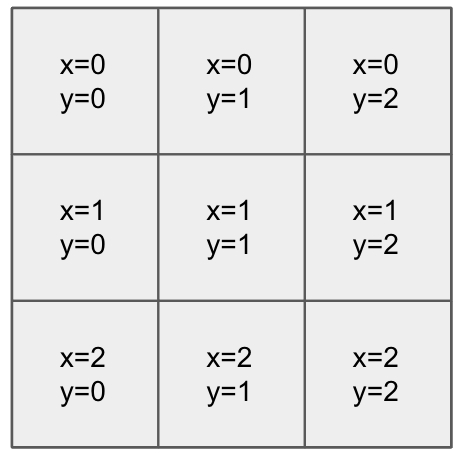Exercise #3: CCIP Tic Tac Toe
Let's play a cross-chain game
Getting started
For the final example of this Masterclass, we are going to deploy and play the CCIP Tic Tac Toe game.
To play the game, we will need to deploy the TicTacToe smart contract on two different blockchains. By sending a transaction on the source chain, which can be either "start" or "move," the state of the game board will be modified, and these states will be "synchronized" by Chainlink CCIP on the other chain.
It is developed using Hardhat, so you will need to prepare the environment by cloning the repository from GitHub by running the following command:
git clone https://github.com/smartcontractkit/ccip-tic-tac-toeThen install packages:
npm installAnd finally, compile smart contracts:
npx hardhat compileSet environment variables
We are going to use the @chainlink/env-enc package for extra security. It encrypts sensitive data instead of storing them as plain text in the .env file by creating a new .env.enc file. Although pushing this file online is not recommended, if that accidentally happens, your secrets will still be encrypted.
Set a password for encrypting and decrypting the environment variable file. You can change it later by typing the same command.
npx env-enc set-pwNow set the following environment variables:
PRIVATE_KEY=""
ETHEREUM_SEPOLIA_RPC_URL=""
OPTIMISM_GOERLI_RPC_URL=""
ARBITRUM_TESTNET_RPC_URL=""
AVALANCHE_FUJI_RPC_URL=""
POLYGON_MUMBAI_RPC_URL=""To set these variables, type the following command and follow the instructions in the terminal:
After you are done, the .env.enc file will be automatically generated.
If you want to validate your inputs, you can always run the next command:
Deploy TicTacToe smart contract
Where the list of supported chains consists of (case sensitive):
ethereumSepolia
optimismGoerli
arbitrumTestnet
avalancheFuji
polygonMumbai
For example, if you want to deploy contracts to Ethereum Sepolia and Avalanche Fuji, run the following commands:
Transfer native tokens to the TicTacToe smart contract
After the deployment of the contract, you must transfer native tokens to these two contracts, respectively.
For example, if you deployed contracts to Avalanche Fuji and Ethereum Sepolia, please transfer 2 AVAX and 0.01 ETH to contracts on Avalanche Fuji and Ethereum Sepolia, respectively.
Update router
Please use the commands below to update the Router address for ccipSend.
Router addresses are listed below:
Ethereum Sepolia: 0xd0daae2231e9cb96b94c8512223533293c3693bf
Polygon Mumbai: 0x70499c328e1e2a3c41108bd3730f6670a44595d1
Optimism Goerli: 0xeb52e9ae4a9fb37172978642d4c141ef53876f26
Avalanche Fuji: 0x554472a2720e5e7d5d3c817529aba05eed5f82d8
Arbitrum Goerli: 0x88e492127709447a5abefdab8788a15b4567589e
Player 1 starts a game
You can start a new game through a TicTacToe contract on any chain. The player who starts a game is player 1. Player 1 needs to send a transaction to create a session, allowing the other player on the other chain to join that session and make a move.
Start a game with the command below:
You will see the message below in the terminal, and that means the message is sent by CCIP.
While the message is sent to CCIP, the status will not be synced until the message is finalized on the source chain and written into the contract on the other chain. Check the information in CCIP Explorer and find the message below to make sure the message is sent to the dest chain.
Get session ID by index
In order to join a game, a player needs to know the session ID of the game.
Get the session ID of the game by index with the command below:
Player 2 makes a move in Blockchain 2
Player 2, on the other chain, can make a move within the game session. The player needs to select a position with x and y coordinates(the range of x and y are from 0 to 2) with the command below:
The x and y are coordinates on the board. eg:

Player 1 makes a move in Blockchain 1
After player 2 made the move, player 1 can make the move with x and y coordinates. Please note that transaction will fail if the position represented by x and y coordinates is occupied.
Player 1 makes a move with the command below:
Repeat the previous two steps until the game is over
Repeat the previous two steps until either combination of player 1 or player 2 matches a winning combination.
Check the winner
Check the winner by command:
You can also check the winner from the contract on the other blockchain with the command:
Front-end of Tic-Tac-Toe
This project has a frontend implementation of a decentralized, multiplayer Tic-Tac-Toe game built with React, Wagmi, and Alchemy SDK.
Features
The game state is stored in the blockchain, enabling transparent and trustless gameplay.
Real-time interaction between two players from different blockchain networks.
Responsive design for a comfortable gaming experience on various devices.
An integrated game log to inform users about the game's progress.
Run
Change the directory by running the following command:
Install the dependencies:
Start the local server:
You can now access the application at the http://localhost:3000 in your browser.

Last updated